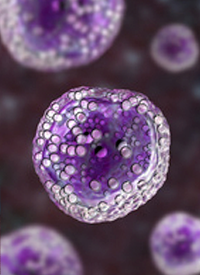News
Article
Iopofosine I 131 Meets MRR End Point in R/R Waldenström Macroglobulinemia
Iopofosine I 131 generated a major response rate of 56.4% in patients with relapsed/refractory Waldenström macroglobulinemia.
Iopofosine I 131 in Waldenström Macroglobulinemia:
© vitanovski - stock.adobe.com

Treatment with iopofosine I 131 (CLR 131) led to a major response rate (MRR) of 56.4% (95% CI, 42%-67%) in patients with relapsed/refractory Waldenström macroglobulinemia who received at least 2 prior lines of therapy, meeting the primary end point of the phase 2 CLOVER-WaM trial (NCT02952508).1
The observed MRR surpassed the prespecified MRR end point of 20%. Furthermore, patients in the modified intention-to-treat (mITT) population (n = 55) achieved an overall response rate (ORR) of 80% and a disease control rate of 98.2%.
In patients who achieved a major response or overall response, the median duration of response (DOR) was not yet reached. The 18-month progression-free survival rates were 78% for patients experiencing a major response and 72% for those achieving an overall response.
“The outcomes observed in this study continue to far exceed expectations and provide evidence of the potential for iopofosine in a broad range of [patients with] Waldenström macroglobulinemia, including difficult-to-treat subgroups. We believe with these results that iopofosine I 131 has the potential to become the standard-of-care therapy for relapsed/refractory patients,” James Caruso, president and chief executive officer of Cellectar Biosciences, stated in a news release. “It is our commitment to ensure that iopofosine will be made available to patients awaiting a meaningful new treatment option. To this end, we plan to submit our new drug application in the fourth quarter of 2024 and will be seeking priority review, which provides an estimated 6-month regulatory review period.”
Iopofosine I 131 is a small-molecule phospholipid drug conjugate designed to deliver the radioisotope iodine-131.
CLOVER-WaM was an expansion cohort of the open-label, multicenter CLOVER-1 trial enrolling patients with select relapsed/refractory B-cell malignancies. In CLOVER-WaM, patients needed to have histologically or cytologically confirmed Waldenström macroglobulinemia, and at least 2 prior lines of therapy were required. Notably, patients with lymphoblastic lymphoma were potentially allowed to enroll in this cohort with permission of the sponsor.2
Key inclusion criteria for the CLOVER-WaM cohort included an ECOG performance status of 0 to 2; a life expectancy of at least 6 months; measurable immunoglobulin M above the upper limit of normal, at least 1 measurable nodal lesion with a longest diameter greater than 15 mm, and 1 measurable extranodal lesion with a longest diameter of more than 10 mm.
Patients were excluded from the study if they had ongoing grade 2 or higher toxicities associated with prior treatment, other than alopecia; received prior external-beam radiotherapy leading to more than 20% of the bone marrow receiving more than 20 Gy of radiation; underwent prior total body or hemi-body radiation; received anticancer therapy within 2 weeks of the first dose of iopofosine I 131; or required acute treatment for Waldenström macroglobulinemia.
Enrolled patients received iopofosine I 131 as a single dose, as multiple doses, or as a fractionated dose.
MRR served as the primary end point of CLOVER-WaM. Secondary end points included ORR, treatment-free survival, DOR, and clinical benefit rate.
In the mITT population, the median age was 70 years (range, 50-88), and patients received a median of 4 prior lines of therapy (range, 2-14). Approximately 27% of patients were refractory to all available therapies, including a BTK inhibitor, an anti-CD20 antibody, and chemotherapy. Forty percent of patients were dual-class refractory to a BTK inhibitor and rituximab (Rituxan).1
Additional data showed that responses were observed across subgroups of patients, which included an ORR of 81% in patients with MYD88 wild-type disease (n = 16), 80% in patients with P53-mutated disease (n = 5), 72% in patients treated after a BTK inhibitor (n = 39), 59% in patients with dual-class refractory disease (n = 22), and 53% in patients with triple-class refractory disease (n = 15).
Safety data were consistent with previously reported findings for iopofosine I 131. No cardiovascular, renal, or liver toxicities were reported, and no patients experienced peripheral neuropathy or significant bleeding. The most common treatment-emergent adverse effects were hematologic, including thrombocytopenia, neutropenia, and anemia.
References
- Cellectar Biosciences’ iopofosine I 131 exceeds primary endpoint in Waldenstrom’s macroglobulinemia pivotal study with 78% of major response patients remaining progression free at 18 months. News release. Cellectar Biosciences. July 23, 2024. Accessed July 23, 2024. https://www.cellectar.com/news-media/press-releases/detail/338/cellectar-biosciences-iopofosine-i-131-exceeds-primary
- Study of iopofosine I 131 (CLR 131) in select B-cell alignancies (CLOVER-1) and pivotal expansion in Waldenstrom macroglobulinemia (CLOVER-WaM). ClincalTrials.gov. Updated June 6, 2024. Accessed July 23, 2024. https://clinicaltrials.gov/study/NCT02952508









